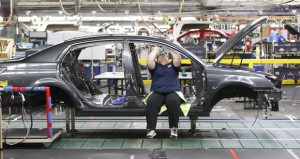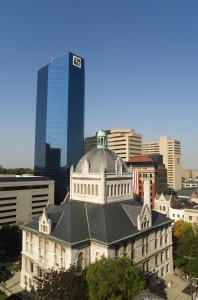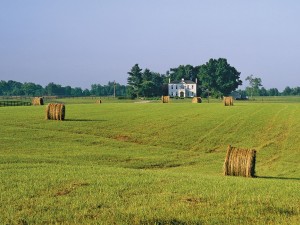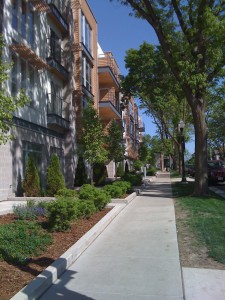This Week’s Featured Op-Ed: It’s Not Farms vs. Factories
It’s not Farms vs. Factories
Op-ed by Knox van Nagell, Published in the Lexington Herald-Leader, September 26th, 2011
In response to Mr. Ruschell’s September 5th Herald Leader op-ed “Open More Agricultural Tracts to Manufacturing Development”, The Fayette Alliance, Kentucky Thoroughbred Association, and Fayette County Farm Bureau would like to make a three points…
First, we believe that for Lexington to become a “great American city”, we must balance a vibrant downtown, healthy well-designed neighborhoods, affordable housing, farmland preservation, and environmental initiatives with the development of our resources to accommodate growth.
This is a proven recipe that will continue to produce a unique quality of life here in Lexington-Fayette County.
In this time of recession and uncertainty, our quality of life is our biggest calling card for economic development and job creation, as 70% of workers pick city first and job second in today’s technology age…Where the workers choose to live, is where the companies choose to go—as documented by Richard Florida, Rebecca Ryan, and other socio-economic experts.
It’s true that every city in America is hurting for jobs, and competing for companies. However, those with the strongest economies have a defined “sense of self” and brand that can recruit and retain the “best and the brightest”—of which Lexington has one of the largest populations in the country thanks to the University of Kentucky, Transylvania University, BCTCS, and others institutions of higher learning.
So a balanced and sustainable growth strategy is instrumental to becoming a “destination” for a strong, creative and recovering economy—and manufacturing plants on our farms would jeopardize the value and integrity of our acclaimed Bluegrass “brand” that’s essential to “drawing” everyone from doctors and young “creatives” to corporations to Lexington.
Second, our rural area is the foundation of a $3 billion agricultural economy that is a pillar of international commerce and local economic activity. Because of this role, we strongly support the PDR program and the Rural Land Management Plan that governs how to use and protect our precious farmland.
The Rural Land Management Plan was adopted roughly ten years ago, after a diverse cross-section of our community—including leaders from the homebuilding, real estate, business, neighborhood, equine, and agriculture sectors—met for two years to determine how best to manage and promote our irreplaceable Bluegrass farmland and its various economic, natural, and cultural resources.
Their work led to our nationally acclaimed PDR program, the forty-acre minimum rule in the rural area, one of the largest National Historic Districts in the United States, and countless other land-use initiatives designed to preserve and enhance our priceless farms and agricultural economy.
Like Toyota and Lexmark, our equine and general agriculture industries are major economic drivers that too have a “factory floor” of their business. Instead of bricks and mortar, our signature industries exist not in a physical building, but on our finite Bluegrass soils and farmland. Any sound business plan manages and leverages its facilities or factory for purposes of economic growth…and our farms are no different.
Although our entire economy is in a state of contraction…from finance and homebuilding, to manufacturing and the horse industry…we have even more to lose if we don’t “mind the store” in our rural area. Here are some key facts about our farms and what they mean to our local economy:
Lexington-Fayette County is the capitol of a regional $3 billion agricultural economy. Our Rural Services Area supports over 21,000 local jobs—from farm laborers, suppliers, and tour guides to lawyers, vets, animal science researchers, and sales agents. Vet payroll alone contributes over $17 million a year to our local government.
Keeneland and Fasig Tipton are, respectively, the LARGEST thoroughbred sales agencies in the world…Last year attracting international investors to Lexington from 49 different countries, and selling over a billion dollars worth of thoroughbreds.
The thoroughbred industry, as reflected by the recent Keeneland, Fasig-Tipton, Saratoga, and OBS sales, has stabilized. The average and gross sales prices have increased 20-40% from previous years. While projected foal crops are down, Lexington and the state of KY are still the epicenter of an international industry, and breeds, foals, and raises more thoroughbreds than all other states COMBINED.
And Fayette County is not just about thoroughbreds…We’re the largest beef producing state east of the Mississippi River. The Bluegrass Stockyards, located in downtown Lexington, is the second largest stockyard in the United States. Last year it sold roughly $144 million locally, and $350 million statewide, in cattle alone.
Food is a big deal. With grocery prices, transportation costs, and populations reaching record highs, Fayette County farmers are growing more food to satisfy demand—with crop receipts totaling over $14 million. With improved processing, distribution, and marketing systems in place, food could become an incredibly powerful Fayette County industry in the near future. Other cities have taken advantage of this opportunity, and created a major business. For example, Madison, Wisconsin is the capitol of a $9 billion food industry. Fayette County could follow in Madison’s footsteps, as Lexington is located a day’s drive within 70% of the U.S. population…creating an ideal market condition for this emerging industry.
And tourism is huge here…The World Equestrian Games had a $201 million statewide economic impact, and jumpstarted a growing and documented sport-horse industry in Fayette County. The KY Horse Park is home to 35 national equine operations which contribute over $260 million to our local economy.
Moreover, nearly 2 million tourists came to Lexington last year to visit the Horse Park and Fayette County farms—investing needed money in our hotels, restaurants, and local businesses. Tourism alone generates $15 million in local tax receipts every year…and many tourism initiatives are ongoing. A young program is underway at the Kentucky Thoroughbred Association to aid in booking public horse farm tours—more than 1200 hours of tours were completed in 2010. And this fall, the Mayor is convening a committee to examine challenges and opportunities for agritourism in Fayette County.
In light of these facts, it’s apparent that not all counties in the Bluegrass Region have the soils or ag-infrastructure that exist here.
Therefore, we need to continue to play to our strengths in Lexington-Fayette County, and envision ways to support and pursue the market opportunities agriculture affords. Farms are not “empty” acres waiting for a “better use” as Mr. Ruschell suggests. Rather, they are a finite environmental resource that can meaningfully sustain the industries of tomorrow.
Third, Fayette County farms also “pay their way” in community services and maintenance…For every dollar of revenue they generate for the city, they cost the city 93 cents to service in police, fire, etc.—generating a net gain of roughly seven cents on the dollar to LFUCG, as opposed to other, more intensive land uses. From an infrastructure standpoint, farmland is a key component to sustainable city planning.

Team member Crystal Rodimer worked on a Camry moving down the Georgetown assembly line in February 2010. | Lexington Herald-Leader Staff | Kentucky.com
To Mr. Ruschell’s point, we agree that our community should energetically pursue manufacturing and other job-creating opportunities…but on the 429 acres of land zoned for “economic development”, and 12,000+ acres of “underutilized” land located inside the city of Lexington.
In light of our $500 million water quality problems, this approach will ensure that the infrastructure needed for factories and other manufacturing uses will be located where our city can most efficiently and sustainably support them—inside the Urban Services Area. This growth boundary has served our community incredibly well since 1958 when it was established, and we should protect it.
Nonetheless, we must continue to work with our partners in adjoining counties to pursue manufacturing and other business activities throughout the Region. Just as we have all benefitted from a Toyota in Georgetown, we too can all benefit from other manufacturing hubs located in the Bluegrass. Regionalism is essential to our collective success.
Simply put, the rural area and its protections should remain intact…because Fayette County agriculture is economic development that benefits all of us.
Don Robinson, Chairman of The Fayette Alliance
Todd Clark, President of Fayette County Farm Bureau
David Switzer, Executive Director of The Kentucky Thoroughbred Association
Previously Featured Op-Eds,
“PDR and Urban Infill: Two sides of the same coin” Op-ed by Knox van Nagell, Published in the Lexington Herald-Leader, January 17th, 2010




